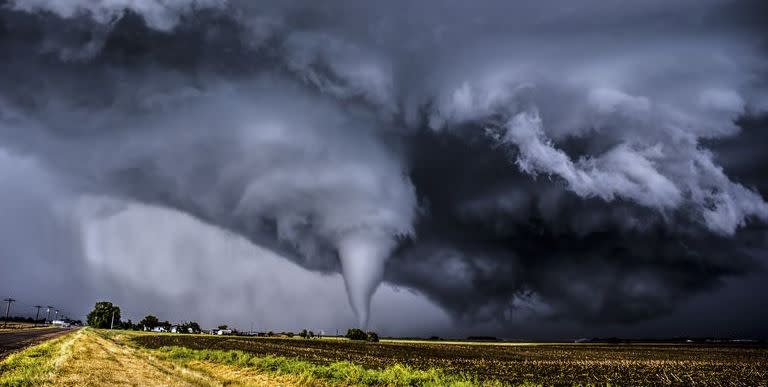It's Almost Tornado Season, So Brush Up on One of Mother Nature’s Most Powerful Phenomena

Tornadoes—one of mother nature’s most incredible and powerful phenomena—are destructive and can be downright deadly, too. In fact, the National Severe Storms Laboratory (NSSL)—a research lab under the umbrella of the National Oceanic and Atmospheric Administration (NOAA)—says that tornadoes “can be among the most violent phenomena of all atmospheric storms we experience,” and unfortunately, they occur pretty frequently. To make matters worse, tornadoes can happen any time of year, although tornado season typically falls between April and June in the U.S.—with approximately 1,200 striking different parts of the country each year.
If you live in Tornado Alley—a spread of plains in the south-central U.S.—you can expect to experience more tornadoes than other portions of the U.S. If you live in an area where tornadoes are not the norm, it doesn’t hurt to learn what causes them, how dangerous they can be, and how to protect yourself and loved ones from their devastation. Here’s what you need to know so you can be ready if you ever encounter one.
Tornado vs. Twister
“Tornado” and “twister” are used interchangeably because they’re basically the same thing: a rotating column of air that spins at high speeds. The width of a tornado can range from a couple of feet to several hundred feet across, and they can last between a few seconds to a half hour although they tend to last an average of ten minutes or less.
How Tornadoes Form
Tornadoes are usually born from thunderstorms. High intensity tornadoes form from supercell thunderstorms, a storm that has a “deep rotating mesocyclone.” Supercell thunderstorms are usually when you’ll hear a tornado warning. A regular thunderstorm will hit before a supercell and for this to occur, a specific set of 'ingredients' need to come together.

The beginning of a thunderstorm looks like this: humid air, which rises, collides with cold air in the atmosphere above it. This creates wind shears, rolling columns of wind that spin above the space where the hot and cold air meet. The warmer air creates an updraft that takes one of the horizontal wind shears and moves it into a vertical position.
The peak of the updraft has two spinning columns on either side of it—the larger of the two columns overtakes the smaller one and becomes the thunderstorm. From here, the storm is able to expand due to the warm air being sucked into the spinning column.
When winds increase in speed and strength and create an updraft, a regular storm becomes a supercell. While the supercell churns in the sky, the chances of it becoming a tornado are slim—only 30 percent of these storms produce a tornado per National Geographic.
Still, there are some things experts don’t understand about tornadoes. For one, scientists still aren’t completely sure why only some storms birth tornadoes. Second, it’s not totally clear how tornadoes die.
“Eventually, the air gets too cold and it chokes off the inflow of new air into the storm,” Harold Brooks, a NOAA research meteorologist, told National Geographic.
Tornado Safety Tips
It’s important to differentiate between a tornado watch and tornado warning.
⚠️ Tornado Watch: According to the NSSL, a tornado watch gets issued by NOAA’s Storm Prediction Center. A watch alert means you need to be prepared for “severe weather and stay tuned to NOAA Weather Radio to know when warnings are issued.” A tornado watch means that a tornado may occur in your area. It doesn’t mean that one will definitely pass through. Make sure you have a plan—for example: knowing where tornado shelters are located, where emergency food and water are, and how to safely use a generator—and supplies ready to go in case a watch turns into a warning.
⚠️ Tornado Warning: A tornado warning will be issued by NOAA’s National Weather Service Forecast Office. If you receive a warning, it means that “a tornado has been reported by spotters or indicated by radar and there is a serious threat to life and property to those in the path of the tornado. A tornado warning indicates that you should ACT NOW to find safe shelter” says the NSSL.
If you’re home, the first thing you should do is get away from windows and move to the lowest level floor.
Find a sturdy piece of furniture to sit under, ideally as close to the center of the room as possible, and cover your head with your arms. If you live in a mobile home, seek refuge somewhere else immediately.
If you’re outside during a tornado, try to get inside a home or building (not a mobile home). If you can’t get inside, get into a low area or place yourself against the building in a low position and be on the alert for flood waters.
If you’re at school or work or in any kind of public building, stay away from windows and open areas such as auditoriums and hallways. Find a sturdy table or piece of furniture to get beneath and protect your head.
If you’re in a car, the Federal Emergency Management Agency suggests you DO NOT try to drive faster than the tornado because they can change direction quickly and without notice. Instead, get out of the car and try to find shelter inside a building. If there are no buildings nearby, try to find a low area where you can wait out the tornado.
It also helps to have a predesignated meeting place where you can find friends and family after the storm has passed. You can also look to Red Cross for more tips on tornado safety and preparedness.
You Might Also Like
